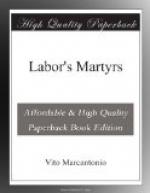In Chicago, the May Day strike was a great success. Those who remember it and took part in it tell us that thousands of workers filled the streets. Some paraded, others gave out handbills, others went in committees from factory to factory calling the workers out on strike. Despite all the efforts of a hostile press to whip up hatred for the workers, to alienate the middle class, to spread the fear of disorder and raise the bogey of revolution (much as Mayor Shields of Johnstown so unsuccessfully tried to do when he attempted to introduce the menace of vigilantism into Johnstown, Pa., during the recent steel-strike with his black helmeted monkeys), the day passed in absolute peace.
One Chicago daily, the Mail, actually carried an editorial addressed directly to Parsons and Spies. It called them every vile name that the censorship would pass and stated that any disorder which might occur should be laid at their door.
In many industries the workers decided to stay out on strike after May 1. One of these was the McCormick Reaper Plant in Chicago. On May 3, August Spies was invited by the strike committee to address the pickets at the factory gate. Just as he finished speaking, the police charged down upon the assembled workmen with clubs and guns. First reports had it that six were killed outright and scores wounded. Chicago papers were quick to point out that only two had lost their lives!
Spies rushed back to the office of the German radical paper, the Arbeiter-Zeitung, of which he was the editor. Hastily he wrote up a leaflet denouncing the police attack, calling for revenge “if you are the sons of your grandsires who have shed their blood to free you.” It ended with a dramatic call to arms, which Spies upon re-reading ordered stricken out. The typesetter left it in and at the Haymarket trial which followed it provided the prosecution with some of its most valuable ammunition in firing the hatred of the jury.
That same evening a committee of trade unionists decided to hold a protest meeting in the Haymarket Square in Chicago, on the night of May 4. Several thousands people attended. Spies opened the meeting and stated its purpose: to discuss the question of the eight-hour day and to protest the police shootings at the McCormick plant. Parsons, who had just returned to the city from a speaking tour was hurriedly sent for and rushed over with his wife, Lucy Parsons, and their two children, to lend a hand.
The speakers stood on an empty wagon for a platform and addressed the crowd for about two hours. Reporters covering the meeting, instructed to take down only the “most inflammatory” remarks made, testified from the witness stand at the subsequent trial as to the mildness of the speeches.
In the audience was the mayor of Chicago, Carter Harrison, who was quickly satisfied by its peaceful nature and went in person to Police Captain Bonfield with instructions to call off police reserves and send his men home. They would not be needed.




